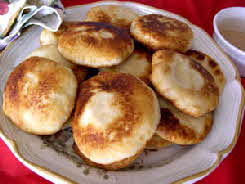High Altitude Breads
We got a call from California this week:
“I can make great bread in L.A. but at my cabin in Montana, it doesn’t turn out so well.”
We would like to help. This summer, you might find yourself at a cabin or in an RV high in the mountains. That doesn’t mean you can’t enjoy great bread.
Can you make bread and buns in the mountains?Yeast products are not as sensitive to altitude as chemically leavened products. We have worked with yeasted breads at almost 11,000 feet in the Rockies. The trick is realizing that you are working with living creatures and giving them the culture that they need to thrive in—a warm, moist environment. In a healthy culture, yeast organisms feed on the sugars and starches in the dough, multiply rapidly, and expel carbon dioxide gases that make the dough rise. If the dough is not moist enough, it will take much longer for the dough to rise. Yeast organisms are very sensitive to temperature. If the dough is too cool, the yeast organisms do not multiply as rapidly and produce less gas.

High Altitude Recipe TipsThe recipe that works so well for you on the coast may not work so well in the Rockies. But it may not be the altitude; it may be the humidity. In a humid location, unsealed flour absorbs moisture; in a dry climate, that same flour dries out. If you add the same amount of water to flour in both locations, the dough in the humid climate will be much moister. But the solution is simple: add enough water that the dough is soft and moist.
At higher altitudes, your kitchen may be cooler than it is at home. A few degrees difference in temperature will make a substantial difference in the time it takes your dough to rise. Compensate by taking advantage of the warmest spot in the kitchen. (At 11,000 feet in the Rockies, we had to move a tent to the warmest spot we could find, banking the tent into the sun.)
There are some other tricks that you can deploy to help that yeast along. A little extra sugar will feed the yeast and speed growth. An extra teaspoon per loaf will do and probably won’t make a noticeable difference in your recipe. Salt retards yeast growth. If you cut the amount of salt in a recipe by 1/2 teaspoon per loaf, you will speed the yeast along.
Be patient, be willing to experiment a little, and be cognizant of the yeast culture and you’ll soon have perfect bread at any altitude.
Courtesy of the Prepared Pantry - www.preparedpantry.com
| 